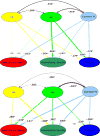Temperament factors and dimensional, latent bifactor models of child psychopathology: Transdiagnostic and specific associations in two youth samples
- PMID: 28264785
- PMCID: PMC5439427
- DOI: 10.1016/j.psychres.2017.02.061
Temperament factors and dimensional, latent bifactor models of child psychopathology: Transdiagnostic and specific associations in two youth samples
Abstract
Common emotional and behavioral symptoms co-occur and are associated with core temperament factors. This study investigated links between temperament and dimensional, latent psychopathology factors, including a general common psychopathology factor (p factor) and specific latent internalizing and externalizing liabilities, as captured by a bifactor model, in two independent samples of youth. Specifically, we tested the hypothesis that temperament factors of negative affectivity (NA), positive affectivity (PA), and effortful control (EC) could serve as both transdiagnostic and specific risks in relation to recent bifactor models of child psychopathology. Sample 1 included 571 youth (average age 13.6, SD =2.37, range 9.3-17.5) with both youth and parent report. Sample 2 included 554 preadolescent children (average age 7.7, SD =1.35, range =5-11 years) with parent report. Structural equation modeling showed that the latent bifactor models fit in both samples. Replicated in both samples, the p factor was associated with lower EC and higher NA (transdiagnostic risks). Several specific risks replicated in both samples after controlling for co-occurring symptoms via the p factor: internalizing was associated with higher NA and lower PA, lower EC related to externalizing problems.
Keywords: Bifactor latent models; Child psychopathology; P factor; Risk.
Copyright © 2017 Elsevier Ireland Ltd. All rights reserved.
Conflict of interest statement
The authors have no conflicts of interest.
Figures
Similar articles
-
Adolescent emotionality and effortful control: Core latent constructs and links to psychopathology and functioning.J Pers Soc Psychol. 2015 Dec;109(6):1132-49. doi: 10.1037/pspp0000047. Epub 2015 May 25. J Pers Soc Psychol. 2015. PMID: 26011660 Free PMC article.
-
Internalizing and externalizing problems in adolescence: general and dimension-specific effects of familial loadings and preadolescent temperament traits.Psychol Med. 2005 Dec;35(12):1825-35. doi: 10.1017/S0033291705005829. Psychol Med. 2005. PMID: 16300695
-
The breadth and potency of transdiagnostic cognitive risks for psychopathology in youth.J Consult Clin Psychol. 2020 Mar;88(3):196-211. doi: 10.1037/ccp0000470. J Consult Clin Psychol. 2020. PMID: 32068422 Free PMC article.
-
Understanding comorbidity among internalizing problems: Integrating latent structural models of psychopathology and risk mechanisms.Dev Psychopathol. 2016 Nov;28(4pt1):987-1012. doi: 10.1017/S0954579416000663. Dev Psychopathol. 2016. PMID: 27739389 Free PMC article. Review.
-
Temperament, personality, and developmental psychopathology as childhood antecedents of personality disorders.J Pers Disord. 2005 Apr;19(2):171-201. doi: 10.1521/pedi.19.2.171.62627. J Pers Disord. 2005. PMID: 15899715 Review.
Cited by
-
Exploring Personality Profiles as a Source of Phenotypic Diversity in Autistic Children and Adolescents.J Autism Dev Disord. 2024 Nov 2. doi: 10.1007/s10803-024-06625-7. Online ahead of print. J Autism Dev Disord. 2024. PMID: 39487281
-
Maternal Depressive Symptoms Predict General Liability in Child Psychopathology.J Clin Child Adolesc Psychol. 2022 Jan-Feb;51(1):85-96. doi: 10.1080/15374416.2020.1723598. Epub 2020 Mar 27. J Clin Child Adolesc Psychol. 2022. PMID: 32216604 Free PMC article.
-
Childhood inhibition predicts adolescent social anxiety: Findings from a longitudinal twin study.Dev Psychopathol. 2022 Dec;34(5):1666-1685. doi: 10.1017/S0954579422000864. Epub 2022 Oct 14. Dev Psychopathol. 2022. PMID: 36229958 Free PMC article.
-
An experimental test of the fetal programming hypothesis: Can we reduce child ontogenetic vulnerability to psychopathology by decreasing maternal depression?Dev Psychopathol. 2018 Aug;30(3):787-806. doi: 10.1017/S0954579418000470. Dev Psychopathol. 2018. PMID: 30068416 Free PMC article. Clinical Trial.
-
Evidence for two genetically distinct pathways to co-occurring internalizing and externalizing problems in adolescence characterized by negative affectivity or behavioral inhibition.J Abnorm Psychol. 2020 Aug;129(6):633-645. doi: 10.1037/abn0000525. Epub 2020 May 28. J Abnorm Psychol. 2020. PMID: 32463263 Free PMC article.
References
-
- Achenbach TM, Rescorla L. Manual for the ASEBA School-Age Forms and Profiles. Research Center for Children, Youth, and Families, University of Vermont; Burlington, VT: 2001.
-
- Adams J, Weakliem DL. August B. Hollingshead’s “four factor index of social status”: from unpublished paper to citation classic. Yale J Sociol. 2011;8:11–20.
MeSH terms
Grants and funding
LinkOut - more resources
Full Text Sources
Other Literature Sources


